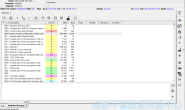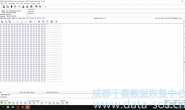这些天,我们所有人都经常面对SMR(叠瓦式磁性记录)硬盘数据恢复。 从本文中,您将了解它们的真正含义,SMR和PMR驱动器之间的区别,如何绕过SMR驱动器中的问题以及如何使用PC-3000 Portable III / Express / UDMA获得数据访问权限。
These days we all very often face modern SMR drives. From this article, you will find out what they actually are, what the difference between SMR and PMR drives is, how to bypass issues in SMR drives and get data access with the PC-3000 Portable III / Express / UDMA Systems.
先讲一点理论。A bit of theory to begin with.
带状磁记录(SMR)技术将每片磁道的数量增加25%。通过在磁头中使用读取器可获得更高的密度,该读取器的宽度比写入器窄4-5倍。 例如,现代驱动器中的写入器宽度为50 µm,读取器为10 µm。 但是,如何记录比作者窄的曲目? 如果磁头写了一个磁道,然后在磁道上添加了另一个磁道,但偏移量等于读取器的宽度,则这两个磁道都是可读的。 结果,记录过程将有点类似于屋顶上的瓦片排列:首先是第一行,然后将下一行以偏移量稍稍放下。 因此,基于效果的磁记录方法的名称。
The Shingled Magnetic Recording (SMR) technology increases the number of tracks per platter by 25%. A higher density is achieved by the use of a reader in a magnetic head, which is 4-5 times narrower than a writer. For instance, the writer in modern drives is 50 µm wide, the reader is 10 µm. But how does it record a track that is narrower than the writer? If the magnetic head writes a track and then adds another one on top of it, but with an offset equal to the reader width, then both tracks will be readable. As a result, the recording process will somewhat resemble tile arrangement on a rooftop: the top row first, then the next row is laid slightly lower with the offset. Hence the name of the magnetic recording method based on the effect.
上图展示了7条带状轨道的外观以及它们是如何产生的。
The figure above demonstrates the appearance of 7 shingled tracks and how they are produced.
首先,驱动器写入磁道1。然后以等于读取器宽度的偏移量写入磁道2。 驱动器以这种方式继续进行,直到写入磁道8,形成磁道7和常规经典磁道8。
First, the drive writes track 1. Then track 2 is written at an offset equal to the reader width. The drive proceeds in this manner until it writes track 8, which forms shingled track 7 and a regular classic track 8.
现在,您可能会问:如果读取器的体积小5倍,而记录的密度却高5倍,为什么实际密度仅增加25%? 实际上,磁头定位系统的当前精度为+/- 7 µm。 这一事实防止了形成小于35 µm的轨道。
Now, you may ask: why is the real density increase only 25% if the reader is 5 times smaller enabling recording 5 times denser? Actually, the current precision of the head positioning system is +/-7 µm. This fact prevents the creation of a track narrower than 35 µm.
叠瓦式磁性记录的密度增加带来了代价。 实现更高容量的能力在表面上强加了相当复杂的数据排列。 该要求有一个明确的理由:要重写单个数据扇区,不仅必须重写具有该扇区的磁道,还必须重写其后的所有磁道。
The increased density of shingled recording comes with a price. The ability to achieve higher capacity imposes considerable sophistication of data arrangement on the surface. The requirement has a solid reason: to rewrite a single data sector, you have to rewrite not just the track with that sector but also all the tracks that follow it.
当然,要在任何地方重写数据,必须先从该位置读取数据。 因此,如果整个驱动器排列在带状的磁道中,则对单个位进行修改将需要从该位的位置到磁盘空间末端读取和写入所有磁道。 因此,书写性能将下降极大的因素(数十万次)。 显然,没有办法完全避免写入性能的下降。 但是有什么办法可以加速它吗?
Of course, to rewrite data anywhere, you have to read it from that location first. Thus, if the entire drive is arranged in shingled tracks, the modification of a single bit will require reading and writing of all the tracks from the bit’s location until the end of disk space. Consequently, the writing performance will drop by a huge factor (hundreds of thousands of times). Obviously, there is no way to avoid a decrease in writing performance altogether. But is there any way to accelerate it?
有。 为此,将SMR磁道合并为较小的组,称为频带,因此仅将每个频带内的磁道都混在一起。 每当需要修改数据时,磁道的这种分组都允许仅读取和重写有限数量的磁道,而不是读取整个磁盘,并且此细节大大加快了处理速度。
There is. And to do that SMR tracks are combined in smaller groups referred to as bands and therefore only tracks within every band are shingled. Whenever data needs to be modified, such grouping of the tracks allows to read and rewrite just a limited number of tracks instead of the entire platter, and this detail speeds up the process considerably.
但是,当操作系统请求对100个扇区中的数据进行修改时,会发生什么情况(不幸的是,这些扇区位于不同的频段内)? 显然,驱动器将再次耗费几乎所有时间来处理请求,并且如果在完成之前关闭电源,则数据将不太可能保持可访问性和完整性。 为了避免这种情况,针对每种驱动器类型,考虑其应用范围,设计了特定的带宽和记录缓冲系统
But what happens when the operating system requests data modification in 100 sectors, which are unfortunately located within different bands? Clearly, the drive will again take almost an eternity to process the request and if a power shutdown occurs before it completes, the data will be very unlikely to remain accessible and intact. As an attempt to avoid such scenarios, specific band size and recording buffering system are designed for every drive type considering the area of their application.
可以识别三种支持混合记录的设备:
Three main types of devices supporting shingled recording are recognized:
1) Drive Managed 驱动管理
2) Host Managed 主机管理
3) Host Aware. 主机应答
类型2和类型3是在用于数据中心的特定设备中设计和运行的,它们不会在标准计算机上运行。 但是,类型1已被广泛使用。 让我们对其进行详细描述。
Types 2 and 3 are designed and operated in specific equipment for data centers, they will not run in standard computers. However, type 1 is already widely used. Let us describe it in detail.
由驱动器管理的SMR驱动器不需要更改主机的BIOS或操作系统。 读取/写入过程的整个复杂性由驱动器本身的缓存系统处理。 存储在这种驱动器上的数据的任何更改都首先在带状频段之外的区域进行,并记录在特殊的修改列表中,在西部数据公司中称为辅助转换器,在希捷中称为媒体缓存。 这些修改稍后会在读取时或在设备空闲时写入带状频段。 但是,当连续执行写入操作时,驱动器最终会耗尽高速缓存空间,并在重新组合数据并将其写入带中时停止处理新请求一段时间。
Drive managed SMR drives do not require changes to the BIOS or operating system of the host computer. The entire complexity of the reading/writing processes is handled by the caching system of the drive itself. Any changes to the data stored on such a drive are first made in areas outside the shingled bands and registered in a special list of modifications referred to as the secondary translator in Western Digital and as media cache in Seagate models. These modifications are written to the shingled bands later while reading them, or when the device is idle. However, when writing is performed continuously, the drive eventually runs out of cache space and stops processing new requests for some time while reassembling data and writing it to the bands.
总结
To summarize.
SMR技术可以更合理地利用磁盘空间来增加硬盘容量。 将磁盘与SMR一起使用不需要对接口或驱动器的外形尺寸进行任何升级,因此,大多数用户不会注意到向这项新技术的过渡。 缺点是与传统的PMR光盘相比,写入速度的下降很小。 显然,如果二级转换器或媒体缓存表丢失,这种HDD操作算法不会提高其可靠性,并使数据恢复严重复杂化
SMR technology applies a more rational use of disk space to increase the capacity of a hard disk. The use of disks with SMR does not require any upgrade of the interface or the form factor of the drives, so the transition to this new technology will go unnoticed by most of the users. The disadvantage is a small drop in write speed compared to traditional PMR discs. Evidently, such an algorithm of HDD operation does not improve its reliability and seriously complicates data recovery if the secondary translator or media cache tables get lost.
实际上,逻辑访问(LBA)考虑了扇区的转换并跳过了缺陷(隐藏在缺陷列表中)。
In practice, the logical access (LBA) takes into account the translation of sectors and skips defects (hidden in the defect lists).

SMR驱动器按频段组写入数据。 第二级翻译器考虑了这一点,HDD FW显示了文件和文件夹的良好结构。 但是,如果第二个转换器(SMR)损坏,我们将在所有扇区中将其设为零。
SMR drives write the data by groups of bands. The second-level translator takes this into account, and HDD FW displays the good structure of files and folders. But if the second translator (SMR) is damaged, we will get zeros in all sectors.
转载请注明:成都千喜数据恢复中心 » 如何使用PC-3000恢复WD(西部数据)SMR(叠瓦式磁性记录)硬盘二级编译器损坏的数据







